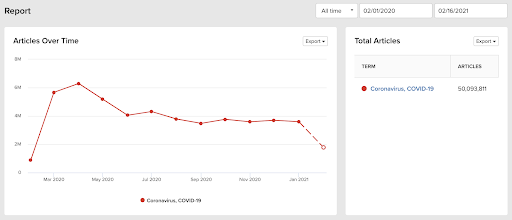There was a time not so long ago when organizations could navigate the ebb and flow of the 24/7 news cycle to maximize how and when they shared important corporate developments. Much of the traditional news cycle ended in March 2020, as COVID-19 took over the news like nothing we have ever seen before. And rightfully so, as it’s affecting millions of people around the world in myriad ways.
For B2B technology firms – a market category Bluetext frequently works with – a status quo media relations strategy will not cut it. Between the pandemic and the media domination of the Trump Administration, one could argue we’ve operated in a relentless “breaking news” cycle for the past 4+ years – creating an unprecedented challenge for B2B brands to get their message in front of the right audience at the right time.
Here are 4 considerations for your B2B PR strategy during the pandemic:
Find your story, but don’t chase it
Ambulance chasing is never the right PR strategy. But throughout the pandemic, many B2B firms are playing a role in protecting citizens and workforces – or helping businesses and consumers adapt to the world we now live in.
Whether your work involves efforts to deliver advanced data analytics being used to inform health and economic decisions, technology to improve contact tracing efforts, or cybersecurity solutions to protect the ever-expanding attack surface brought on by near-full remote work, there are stories to be told and people who want to hear them. So, find your story; but don’t chase it. Your voice during extended crisis events like the pandemic must be authentic and focus efforts on contributing to the conversation, not the bottom line.

Don’t wait long for news cycle gaps
If you are waiting for the news cycle to slow, give it up man. The pandemic will remain the prevailing narrative for months to come. Stay committed to your PR strategy, but depending on the nature of each news announcement, ensure the messaging is relevant to the current environment businesses, workforces and consumers face. Even in today’s news cycle, there is room for stories that are about things other than COVID. Product launches, funding news, survey data, and company milestones will all continue to be covered––and it’s possible to share this news without being tone-deaf to the economic realities of today. While it may not receive the broad coverage typically expected before the pandemic, if it’s a good story and important to your business it’s likely that there is a publication that’s open to writing about your news. This leads us to the next tip…

Know your beats and boundaries
Journalists have been dealing with the same work and life challenges as the rest of us. With so many working remotely, some PR flacks are blurring the lines between business and personal communications profiles. If you find yourself dialing a reporter’s cell phone number to pitch them on your client’s new product, first ask yourself which reaction is more likely: will they answer the phone “Hi so and so, great to hear from you” or will the retort be “how in the heck did you get this number?” And if it’s the latter, don’t say you lifted it from a 2015 RSA pre-registered media list. Hitting them up on social media? Maybe. Again, it depends on the nature of your relationship with the reporter and the type of social network communication.
The pandemic has also undeniably shifted newsroom structures and beats. Some reporters have shifted partially or fully to cover various aspects of the pandemic. This requires keeping your finger on the pulse of what reporters are covering – as these shifts may create new challenges and opportunities.

[Almost] Always Be Closing
Within B2B tech yes, reporters still want to hear about groundbreaking technologies. But there is also an awareness by journalists of the broader challenges that organizations face achieving growth, positive company culture, and workforce productivity in a pandemic. In other words, reporters also want to cover the human side of business.
Don’t be afraid to look for stories in new places. Are there employee stories you can highlight? How about the way in which you are keeping employees connected virtually or new ways that work is getting done? These stories may not drive sales but they can help with positive brand awareness and talent acquisition.
Want to find your story? Get in touch with Bluetext.